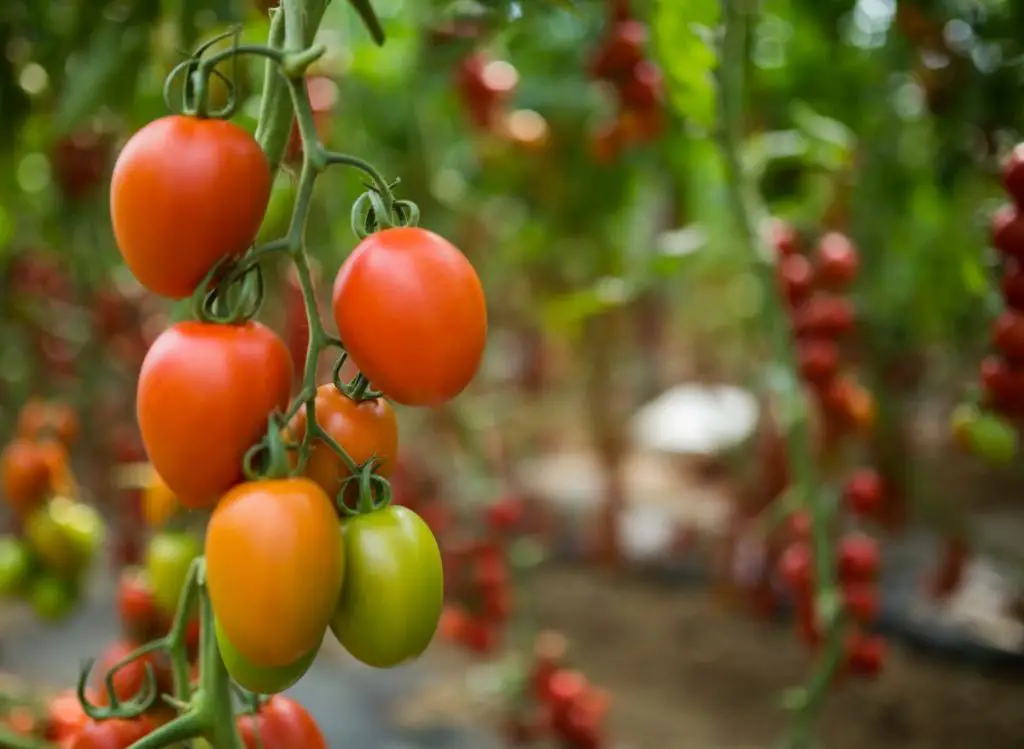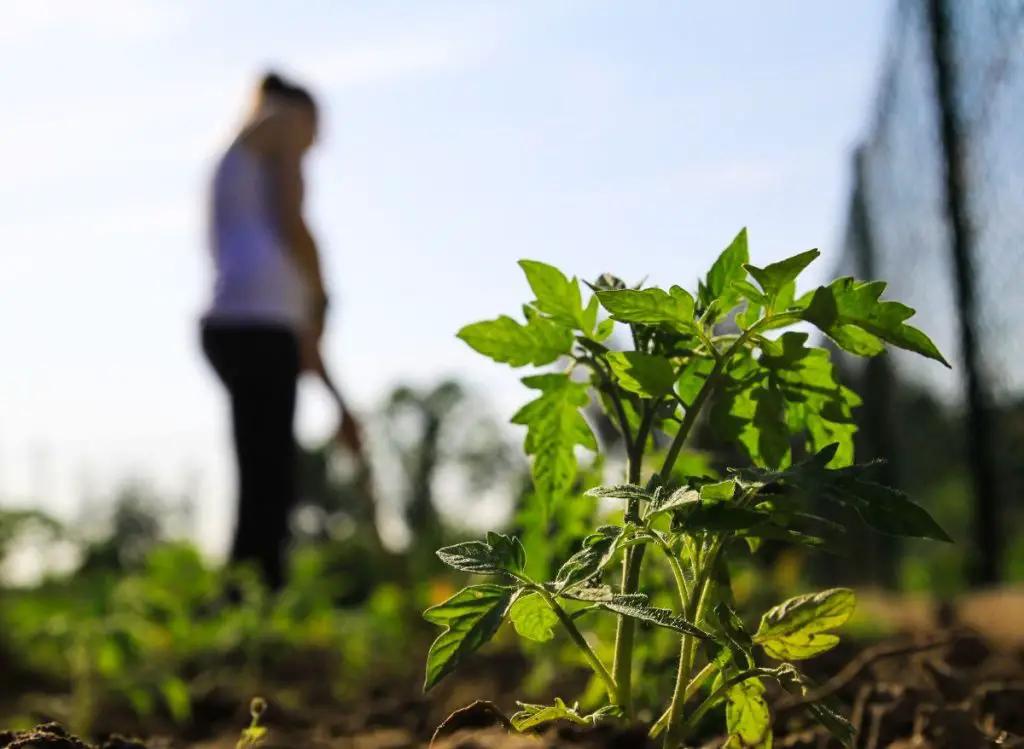
Tomatoes are a favorite of young and old alike and the most popular vegetable to grow in a home garden. They are easy to grow and very productive. Knowing what to plant with tomatoes in raised beds will help you get the most flavor and the biggest harvest possible from your plants.
Check out this list of best tomato companion plants (you probably already grow some of these) so you can have an abundant harvest of fresh tomatoes this gardening season.
A tomato plant plus one of these companion plants would be perfect to grow in a small raised bed or container. Ideal for growing on a balcony, deck, or other small outdoor space.
You might also be interested in reading: Best Ways to Germinate Tomato Seeds Faster.
What is Companion Planting?
Companion planting is the method of growing plants close to each other in your vegetable garden so the plants can benefit from each other. Some companion planting benefits include deterring pests, enhancing plant growth or vegetable production, attracting beneficial insects and pollinators, or even preventing disease (Source: University of Minnesota)
Benefits of Tomato Companion Plants
Tomatoes, borage, and squash are typical companion planting trios, primarily due to timing. Borage is among the most pollinators that repel tomato hornworms (Source: Iowa State University)
Companion plants can improve tomato plant health and yields in several ways. Additional companion planting benefits include enhanced soil and attracting pollinators, pest and weed control, and disease prevention.
According to a study, companion planting is a non-chemical, ecologically-sound way to manage pests.
Here are the most common companion plants for tomatoes:
1- Basil
Basil is an herb that will enhance the flavor of tomatoes growing on the plant and after harvesting in your favorite recipe.
In addition, basil is a good tomato companion plant because the herb repels insects that like to feast on the plant.
You might wonder How Long Does Basil Plant Last; I wrote a whole article that I encourage you to read.
2– Bush Beans
Bush beans grow on a short bush that remains around 2 feet tall and 2 feet wide. When planted near tomatoes, the bushes will increase the air circulation around the taller growing tomato plants.
Bush beans also will not block the sun from sun-loving tomato plants, and pollinating bees love the pollen-filled bean blooms.
You might be interested in reading: Bush Beans Vs. Pole Beans: How They Differ And Which One Is Better?
3- Black Eyed Peas
Also known as Cow Peas, are great to plant as companions for tomatoes. The southern green stink bug, which loves to feed on tomato plants, will be lured away and feast on the Black Eyed Peas.
Some of the peas will be lost, but the tomatoes will be saved.
See also: Growing Pole Beans: 9 Best Ways To Make Them Thrive!
4- Bee Balm
This attractive and fragrant flower attracts pollinators and improves tomato flavor. Bee Balm is an easy-care flower that blooms all summer.
The leaves can be dried and used to make tea. Bee balm also offers other health benefits, including helping with digestive issues, sore throats, bloating, and nausea. Bee balm is a natural antiseptic when used topically; it can help with bee stings and minor wounds.
5- Borage
This herb plant improves the plant’s growth and enhances the tomatoes’ flavor. Plant borage with tomatoes in raised beds to repel hornworms.
People also use borage flowers and leaves for cough, fever, and depression.
6- Carrots
This root crop will help keep the soil loose when planted in raised beds with tomatoes. These two veggies can be planted close together since the carrots don’t need a lot of sun to grow, and they won’t hinder the roots of the tomato plants from growing.
Check out this guide on growing hydroponic carrots if you decide to grow carrots hydroponically.
7- Cilantro
The scent of cilantro masks the scent of tomato plants, so predatory pests have a harder time finding tomatoes.
Cilantro blooms also attract parasitic wasps that feed on tomato hornworms.
8- Clover
Clover provides nitrogen to the soil and prevents weed growth. The fragrant clover blooms also attract pollinators like bumble bees and other beneficial insects.
If you are interested in planting plant clovers in existing lawns, I encourage you to check out this quick guide.

9– Chives
Plant chives with tomatoes in raised beds to improve flavor and attract pollinators. Chives take up very little garden space and can be inter-planted in the raised bed with tomatoes.
Allow some of the chives to bolt and produce flowers to attract bees and butterflies.
10- Coneflowers
Also known as Echinacea, this lovely flower will attract bees, butterflies, and birds to your vegetable garden.
The more pollinators that visit your tomato plants, the more tomatoes you will harvest.
11- Dill
Young dill plants make great companions for tomatoes grown in raised beds. Dill repels aphids which love to suck the sap from tender plant growth.
The herb also attracts beneficial garden bugs like Ladybugs and Praying Mantis.
12- Garlic
The scent of garlic bulbs repels red spider mites, rabbits, and deer. If these pests visit your raised beds, plant garlic around the perimeter of your tomato bed.
See also: Can Tomatoes Grow In Indirect Sunlight? (Find out the truth!)
13– Lemon Balm
This lemony herb will boost the flavor and production of tomatoes. The plant is also a bee magnet, so pollination will be improved.
14- Lettuce
Low-growing lettuce creates a living mulch for tomato plants to help keep the soil cool and moist. The lettuce plants also benefit from being planted in the shade of taller tomato plants.
If you wonder how much light lettuce needs to grow indoors, I encourage you to read this article.
15- Marigolds
The scent of this flower keeps pests away, and should be planted in the corners of raised beds where tomatoes are being grown.
Dwarf marigolds take up very little garden space and will repel pests and reduce root-knot nematodes in the soil.
16- Mint
Plant mint under the tomato plants in the raised beds. The mint will encourage more plant growth and tomato production.
The mint plants trail along the top of the soil and act as a living mulch.
17- Nasturtium
This flower looks lovely when planted in raised beds with tomatoes, and nasturtiums also serve as a trap crop for aphids.
Nasturtiums are edible and make a pretty and tasty addition to salads.
18- Oregano
Allow this fragrant herb to bolt and produce flowers that will attract pollinators to the tomato plants.
Oregano requires very little water, so it won’t rob tomato plants of soil moisture.
19- Parsley
Parsely will attract aphids and keep them off the tomato plants. Parsley also attracts hoverflies that eat aphids throughout the raised bed garden.
You might also enjoy reading: 15 Companion Plants For Swiss Chard (And plants to avoid!)

20- Radishes
Plant radishes near the base of tomato plants in raised beds to act as sacrificial plants for flea beetles. Flea beetles can destroy tomato plants but will choose radishes before tomatoes.
This root crop also helps prevent soil compaction.
21- Sunflowers
Sunflowers attract pollinators and repel aphids. Sunflowers come in heights ranging from 6 inches to 6 feet and come in several colors and sizes.
You might also like: 17 Best Companion Plants For Bush Beans (And 3 to avoid!)
22- Sweet Alyssum
This ground-hugging, spreading plant will keep the soil from drying out in the tomato bed. The sweet fragrance also attracts parasitic wasps that eat aphids.
23- Thyme
This herb repels armyworms and stops them from laying eggs on tomato plants. Thyme also requires very little water to grow and won’t absorb all the moisture from the soil.
Types of Tomatoes
The type of tomato you grow in your raised bed is a matter of personal preference and how you intend to use the tomatoes.
- Indeterminate types ripen throughout the summer and produce vines that need to be supported.
- Determinate types that grow on smaller plants and ripen all at once. Ideal for preserving.
- Tomato sizes range from mini cherry tomatoes that are the size of grapes to large slicing tomatoes that can grow to the size of a dinner plate.
- Tomato colors include red, yellow, pink, orange, green, purple, black, and striped.
- Shapes include round, oval, pear, and cylindric.
Do Not Plant These Near Tomatoes
Some plants make great companions for tomatoes and can be planted in the same raised bed. However, some vegetable and herb plants should not be planted near tomatoes.
Here are some vegetable and herb plants that should not be planted near tomatoes:
- Other plants in the nightshade family should not be planted near tomatoes. This family of vegetables is susceptible to early and late blight, and planting the nightshade family of plants in the same raised bed will increase the chances of blight killing all the plants. Nightshades include tomatoes, peppers, eggplant, and potatoes.
- The risk of a hornworm infestation will also increase if nightshade plants are near each other.
- Anything in the Brassica family will stunt the growth of tomato plants. Plant cabbage, broccoli, Brussels sprouts, cauliflower, turnips, rutabagas, and collards away from tomatoes.
- Fennel secretes a substance from its roots that inhibits tomato plant growth.
- Corn and tomatoes have a common enemy: a destructive worm known by two different names – the corn earworm and the tomato fruitworm. It’s the same worm, and the name just changes based on which vegetable plant the worm is attacking.

